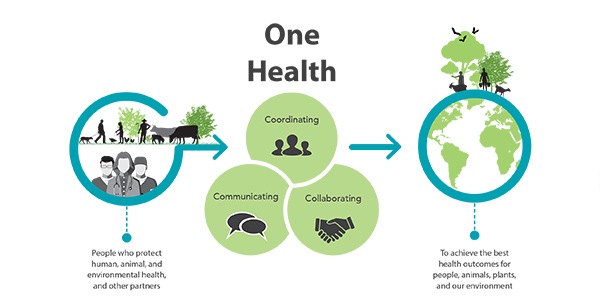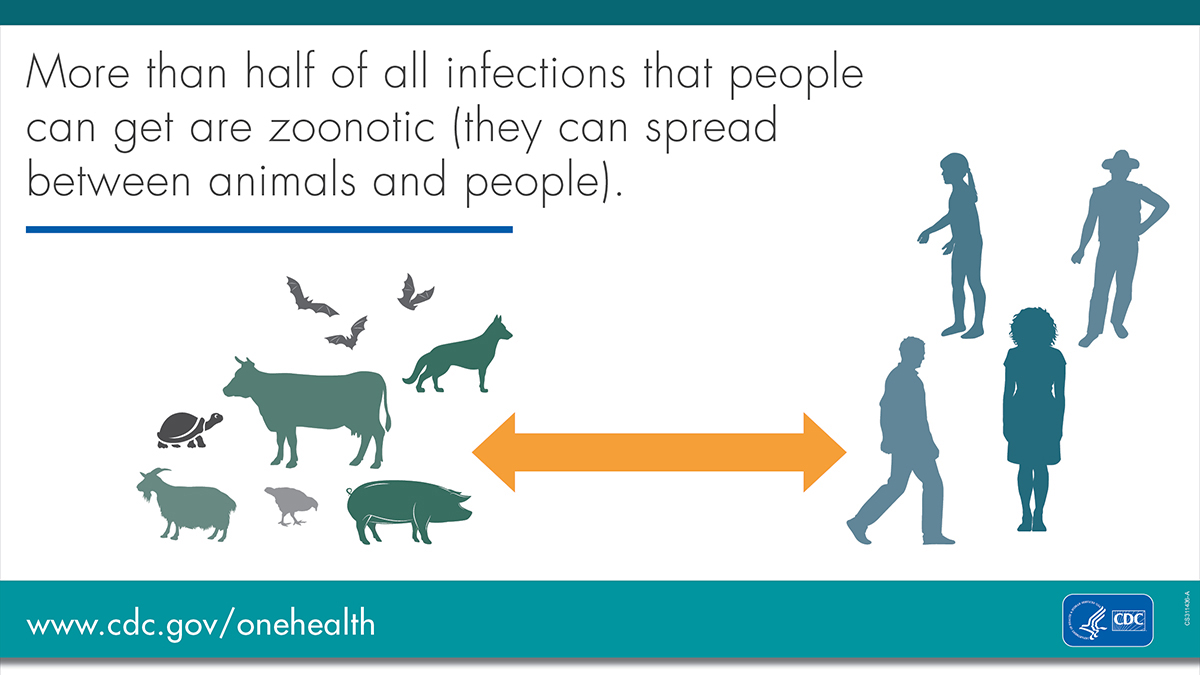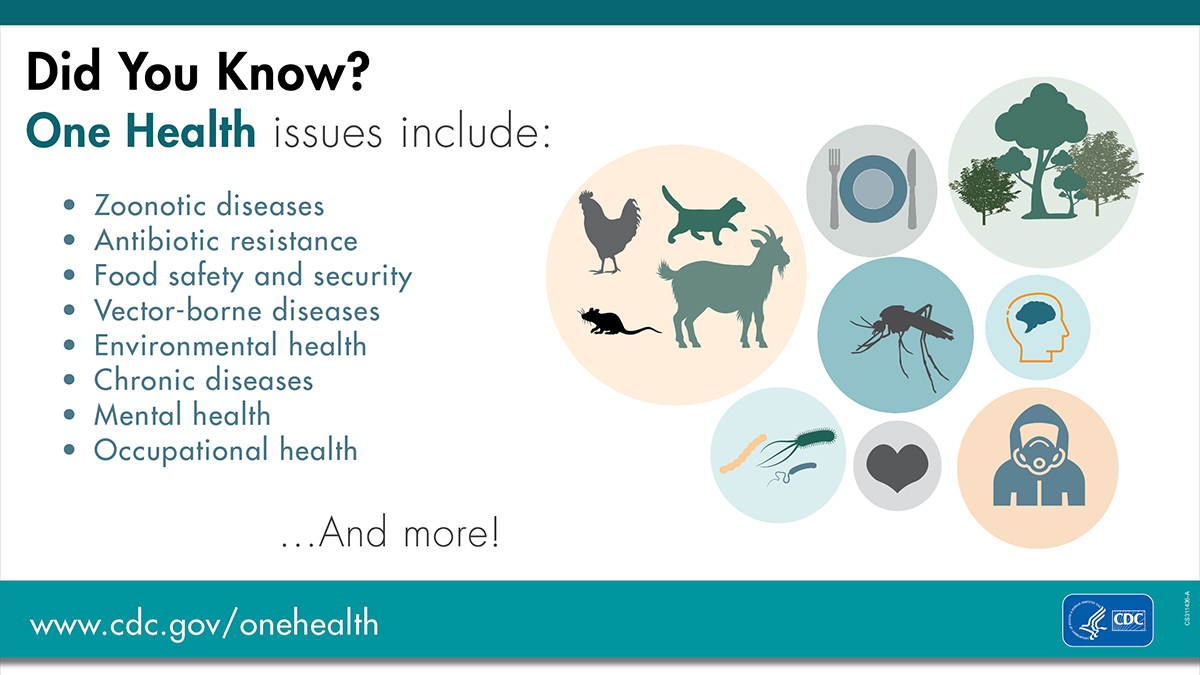The term “One Health” refers to how the health of people, animals, and their shared environment are interdependent. Despite the importance of this multidisciplinary view, it is rarely applied to education standards across the globe. Why is one health education important? What resources are available?
“One Health” is not necessarily a new concept, but it was revived by wildlife conservationists and ecologists during the 1990s. Scientists realized that limited collaboration between experts was stifling innovation that could help solve increasingly complex public health and environmental concerns. The growing threat of antibiotic-resistant microbes to humans and animals is just one example of a one health issue.
An interdisciplinary strategy is crucial because antibiotic resistance is a result of overuse in both humans and animal populations as well as environmental exposure. Organizations like the One Health Commission (OHC) and The National Center for Emerging and Zoonotic Infectious Diseases (NCEZID) have now made it their mission to encourage solutions that follow one health principles by raising awareness, supporting meaningful connections between shareholders, and creating educational resources.

Illustrating the Importance of One Health Education
The increasing incidence of zoonotic disease transmission is an area of focus for one health advocates. Zoonotic diseases are transferred between humans and animals via direct contact or through vectors such as fleas, ticks, mosquitoes, and more. The CDC estimates that 60% of human infectious diseases originate in animals and 75% of emerging infections are zoonotic. Furthermore, research indicates that the changing climate is contributing to an expanding geographic range for vectors that transmit these diseases. The CDC reports that the prevalence of vector-borne diseases like Lyme borreliosis has doubled over the last decade, most likely in part because of this phenomenon.

Children are one of the most vulnerable populations for zoonotic diseases due to their developing immune systems, lack of awareness, and close contact with animal companions. About 38% of American households have at least one dog and 25% have at least one cat. These pets typically spend most of their time indoors and tend to share close quarters with their owners, which lends itself to easy transmission. Transmission may be more likely for children, who are unaware of the risk and less likely to follow proper hygiene practices. Conservation of the human-animal bond is important for many reasons. Growing up around animals has mental and physical health benefits. But children also need to learn how prevent associated health risks.
An example of the need for childhood one health education is the serious yet 100% preventable zoonotic disease that disproportionately impacts children worldwide: rabies. According to the World Health Organization (WHO), about 50% of all human rabies deaths are children under 15 years old. Even though most cases worldwide are due to dog bites, bat exposure is the most common cause of rabies infection in the United States.
Bats are reservoirs for a variety of viral and bacterial pathogens, including rabies and even a unique species of Bartonella called Bartonella mayotimonensis. The CDC publication Vital Signs reports that bats are responsible for 70% of possible rabies infections in the United States and even mentions that this is “possibly because people do not know the risk bats pose”. Children are the most at risk, yet they may not understand that animals such as bats can carry zoonotic pathogens.
This is exemplified in a story from 2017 where a boy in Florida died from rabies after receiving a scratch from an infected bat. Despite being instructed to not do so, the boy tried to touch the bat, which seemed to be hurt. Children are often loving and caring toward animals, and they need information about how to safely interact with them.
In response to this need, the OHC created the Bat Rabies Education Team (OHC B.R.E.T) and developed resources focused on teaching parents and children about the risks of bats.
Advocacy groups are currently working to update educational standards to include more one health principles. However, this takes time and it is important to be aware of what resources are currently available for your own use.
What Resources Are Available?
We highly recommend checking out the resources listed below for ways to incorporate one health education into your and your family’s lives.
One Health Education

- One Health Commission (OHC) National Education
- One Health Commission (OHC) International Education
- One Health Commission (OHC) Higher Education Opportunities
- One Health Social Sciences Initiative
- One Health Education Task Force
- International Student One Health Alliance
One Health University Programs
- Tufts University
- University of California- Davis
- University of Washington Center for One Health Research
- University of Washington One Health Clinic
Conclusion
People, animals, and the environmental are all linked. If one is damaged, the other two are bound to be affected in the short or long term. A growing challenge for people is zoonotic disease transmission, especially for children, whose love of animals we want to encourage while simultaneously protecting their health. A comprehensive one health education is important for ensuring the safety of our families and building a sustainable future in the face of emerging public health challenges.
References
Centers for Disease Control and Prevention. (2017). Zoonotic diseases. Retrieved from https://www.cdc.gov/onehealth/basics/zoonotic-diseases.html
Centers for Disease Control and Prevention. (2019). Bats lead in U.S. rabies risk [Press release]. Retrieved from https://www.cdc.gov/media/releases/2019/p0611-bats-rabies.html
Centers for Disease Control and Prevention. (2019). National health education standards. Retrieved from https://www.cdc.gov/healthyschools/sher/standards/index.htm
Centers for Disease Control and Prevention. (2018, May 4). Vital signs: Trends in reported vectorborne disease cases – United States and territories, 2004-2016. Morbidity and Mortality Weekly Report. Retrieved from https://www.cdc.gov/mmwr/volumes/67/wr/mm6717e1.htm
World Health Organization. (n.d.). Rabies epidemiology and burden of disease. Retrieved from https://www.who.int/rabies/epidemiology/en/
Herriman, R. (2018, January 15). Florida reports 2nd human rabies death in recent months. Outbreak News Today. Retrieved from http://outbreaknewstoday.com/florida-reports-2nd-human-rabies-death-recent-months-23275/
One Health Commission Bat Rabies Education Team. (2020). Bat rabies education. Retrieved from https://www.onehealthcommission.org/en/programs/bat_rabies_education/

